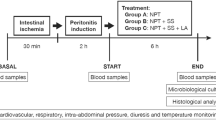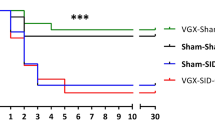Abstract
Background: Laparoscopic surgery has a lower incidence of surgical infection than open surgery. Differential factors that may modify the bacterial biology and explain this finding to some extent include CO2 atmosphere, less desiccation of intraabdominal structures, fewer temperature changes, and a better preserved peritoneal and systemic immune response. Previous data suggest that the immune response and acute phase response are better preserved after laparoscopy. Therefore, we designed a study to evaluate the early peritoneal response to sepsis in an experimental peritonitis model comparing open surgery with CO2 and abdominal wall lift laparoscopy.
Methods: The study subjects comprised 360 mice distributed into the following four groups: group 1, n= 72 (controls); group 2, n= 96 (open surgery), 2–3 cm laparotomy, with abdominal cavity exposed to the air for 30 min; group 3, n= 96, CO2 laparoscopy (5 mmHg pneumoperitoneum) for 30 min; group 4, n= 96, wall lift laparoscopy for 30 min. Intraabdominal contamination in the four groups was induced with 1 ml of E. coli suspension (1 × 104 CFU/ml) 10 min before abdomen closure. Peritoneal fluid and blood samples were obtained 1.5, 3, 24, and 72 h after surgery, and TNF, IL-1, and IL-6 were measured (via ELISA), as well as quantitative culture.
Results: The number of CFU (colony-forming units) obtained in peritoneal fluid and positive blood culture rates were significantly lower in the laparoscopic groups than in the open group. IL-1 peritoneal levels were significantly lower after 24 h and 72 h in the laparoscopy groups. IL-6 levels decreased sharply in the laparoscopy groups at 24 h and 72 h. There were no differences between the two types of laparoscopy models (CO2 and wall lift).
Conclusions: Peritoneal response to sepsis is better preserved after laparoscopy than after open surgery. CO2 does not seem to influence bacterial growth. According to these findings, laparoscopy entails less local trauma and better preserved intraabdominal conditions.
Similar content being viewed by others
Author information
Authors and Affiliations
Additional information
Received: 29 June 1998/Accepted: 25 August 1998
Rights and permissions
About this article
Cite this article
Balagué, C., Targarona, E., Pujol, M. et al. Peritoneal response to a septic challenge . Surg Endosc 13, 792–796 (1999). https://doi.org/10.1007/s004649901101
Published:
Issue Date:
DOI: https://doi.org/10.1007/s004649901101




